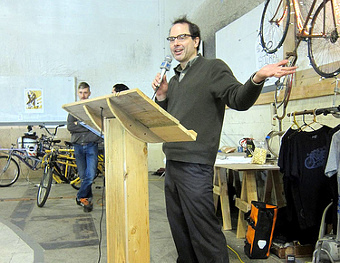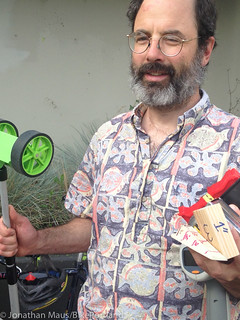An unsafe street that isn’t being improved can be one of the most frustrating experiences in city life. One of Portland’s most thoughtful safety activists has some smart ideas on what to do next.
This exchange in our comments section came from a story this summer about a hit-and-run that injured a nine-year-old girl at North Bryant and Borthwick, on a neighborhood greenway that’s supposed to be free of fast-moving auto traffic but which was, according to a reader who once lived there, built to invite fast speeds. Several readers expressed frustration with the difficulty of getting police to do speed enforcement in a spot like this; one, Kevin Wagoner, said he’s tried calling the city’s official 503-823-SAFE line in a similar situation to no avail.
Here’s Ted Buehler’s response, lightly edited:
I’m disappointed, but not too surprised, that a couple calls to 823-SAFE got the speed issue looked at, but not dealt with.
Here’s two follow-up strategies when initial responses to 823-SAFE calls aren’t enough to get an increased level of compliance.
Part 1
* Call the police non-emergency line (823-3333) and ask for a “Speed Reader Board” That’s the big sign that displays the speeds vehicles are traveling at. It’s more effective than spot-enforcement. Looks like the portable Speed Reader Boards are called “Smart Carts” (not a descriptive or memorable name, but short and unique).
* Call PBOT and borrow some “please slow down” plastic people. Yellow. I used to be able to find them on the website with the “Please Slow Down” plastic signs, but can’t find them now. Here’s the order form.
* Buy some of the yellow plastic figurines that say “please slow down” — I think they sell them at Fred Meyer for about $40. Move them to different houses in the hood each week so folks don’t get complacent.
* Make your own signs that say “please slow down, children live here” “pets live here” etc. Make them pretty big, plant them on posts high enough to see above parked cars. I’ve seen some really nice ones around town.
* Get a radar gun. Use it. Continue to report speeding cars to the authorities. Tape an old cell phone to the side of it to “date stamp” your photos, and then take photos of the offending cars, with their speed readouts, with the time and date. And ask for increased enforcement “Thursdays from 4-5”. I have a Bushnell like this, it’s very easy to use. I loan it freely. ted101@gmail.com BTA has one too. But you might as well get one for yourself.
* Stand in the street with your neighbors. Get a basketball hoop. Get the other grown men out there shooting hoops. Park your car on the greenway and unload a big box. Or stick a lawnmower next to it at the evening commute. People slow down when there’s stuff going on and material in the road.
Part 2
Then, up the ante with your neighborhood association. Portland has very strong neighborhood associations. There’s lots of changes that will only be granted if requested by a NA.
* Show up at the monthly neighborhood meeting, ask the cop again. If the cop blows you off again, talk to the other neighbors after the cop leaves. Ask them if they thought the cop’s response was adequate. If not, tell them you want to work on the project.
* Get your other neighbors to borrow “slow down” and “plastic ‘slow down’ figurines” from PBOT, stick them up all over the neighborhood.
* Your neighborhood probably has a “Safety and Livability rep” and a “Land Use and Transportation” rep. They, or the board chair, can ask the police to come back next month with some other ideas on how the problem can be dealt with. I’m on the Boise board, and I’ve talked to folks on the Humboldt board and loaned them my radar gun for problems on Albina near Rosa Parks (not far from Borthwick and Bryant).
 A 2012 study of bike safety in Vancouver BC
A 2012 study of bike safety in Vancouver BC
and Toronto found that neighborhood greenways are
actually more dangerous than other neighborhood
streets unless they include traffic diverters like
this one, because drivers use them as shortcuts.* Go to the “association of neighborhoods” LU&T or S&L meetings. That’s where 10 or so neighborhood reps all get together. At the “Northeast Coalition of Neighborhoods” (“NECN”) it’s on the fourth Wednesday for LU&T, for instance. Tell them you want a NECN resolution asking for increased police patrol, and regular installations of Speed Readerboard signs in the neighborhoods, especially on the neighborhood greenways.
* Look into further solutions. Bryant and Borthwick? Put in a diagonal diverter somewhere between Albina and Vancouver to cut out the through traffic. The neighborhood association is by far the best entity to use to ask for this sort of thing.
***
While these things might seem like the things government ought to be doing on its own, they’re not doing it good enough for us right now, as evidenced by the 9 yr old girl getting whacked by a driver with a history of speeding who didn’t care enough to stop.
And I think that Portland has made excellent progress in “calming” its streets in recent years. Drivers go slower and more carefully all the time.
But this is only partly a result of governments acting on their own. A lot has been citizens pestering government to get it done. Pestering works. Especially when you’re asking them to 1) enforce existing laws and 2) accelerate a desirable trend.
And by slowing traffic on Bryant, or whatever neighborhood greenway is near your house, you’re also slowing traffic on all the other greenways in the city. The speeding problem can be (partly) rectified everywhere by enforcement and education in just a few places.
This will work. It’s not that much time and effort, all there’s a lot of support for citizens doing this kind of thing in Portland. There is some effort required, but its not like you need to blaze your own trail through a bureaucratic wilderness. The cop in your neighborhood meeting basically flipped you off, but all it takes to pull him into line is a few more steps along the same line of what you’ve already done.
Ted (who’s been active with his own neighborhood association and definitely walks his talk on street activism) is well-known in city government because he’s willing to politely pester authorities offering available solutions to unsolved problems. One of his great insights, I think, is that local governments are composed of human beings with the authority to take small actions if they’re provided with both a motive and an opportunity.
What do you think of his recommendations?



